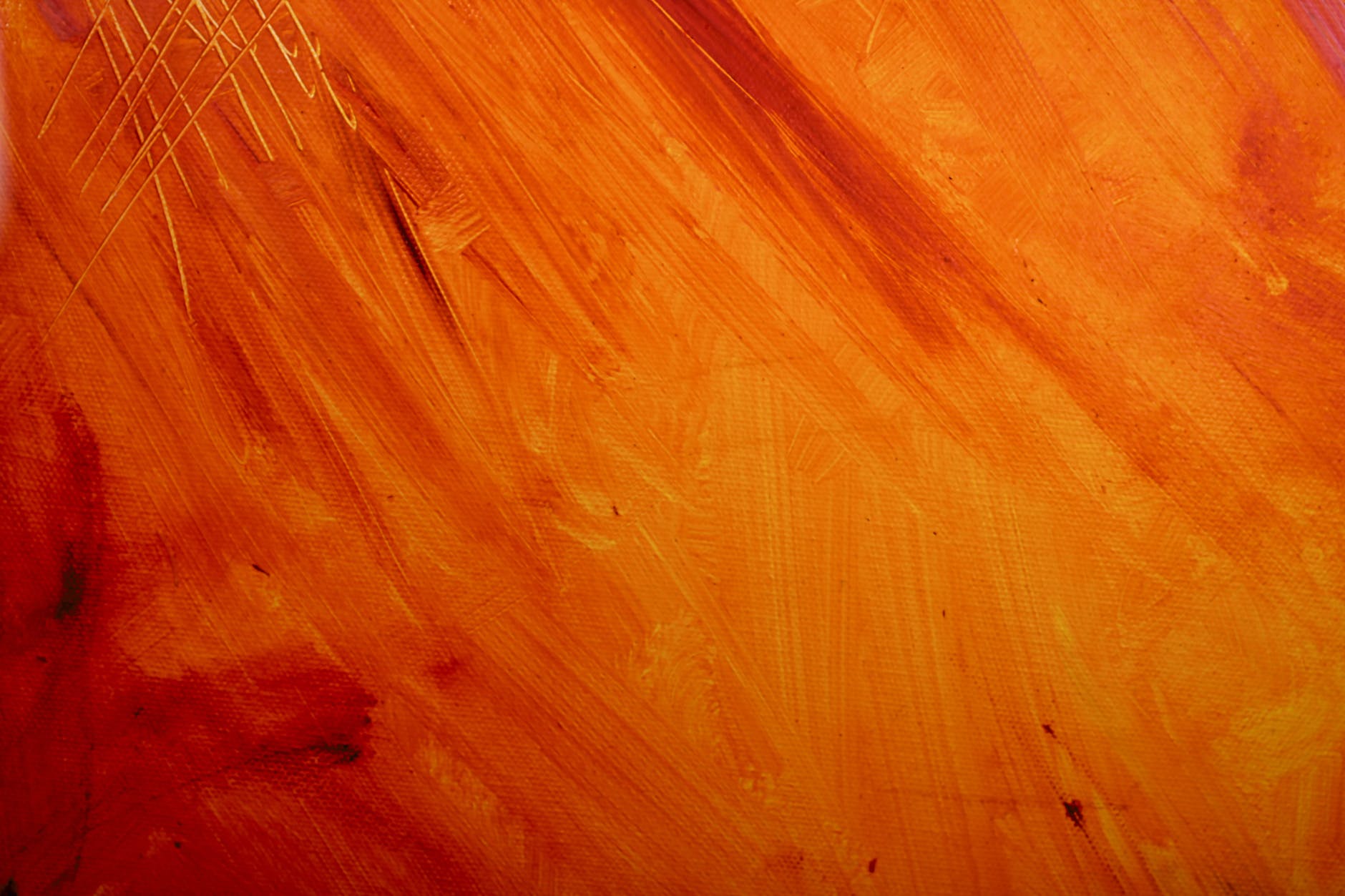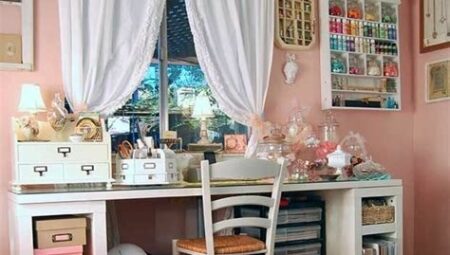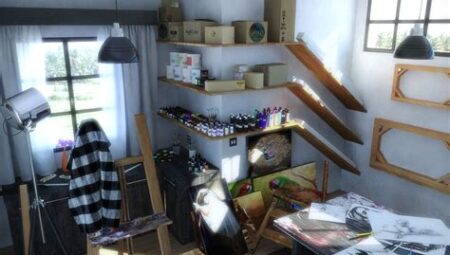Contemporary art has become a prominent feature in modern interior design, revolutionizing the way we perceive and experience spaces. By seamlessly integrating contemporary artworks into the design scheme, a harmonious balance is achieved between artistic expression and the overall aesthetic of a space. This article will delve into the impact of contemporary art on modern interiors, exploring how it enhances the visual appeal and atmosphere of a space.
One of the key benefits of integrating contemporary art into modern interiors is its ability to enhance minimalist spaces. Minimalism is characterized by clean lines, simplicity, and a focus on functionality. However, this design style can sometimes lack visual interest and depth. Contemporary art adds a layer of texture, color, and visual intrigue to these spaces, creating a harmonious balance between simplicity and artistic expression. Whether it’s a vibrant abstract painting or a thought-provoking sculpture, contemporary art can breathe life into minimalist interiors, making them visually captivating and engaging.
Enhancing Minimalist Spaces
Minimalist spaces are known for their clean lines, simplicity, and focus on functionality. While these interiors exude a sense of calm and serenity, they can sometimes feel lacking in visual interest. This is where contemporary art comes in, offering a perfect solution to enhance minimalist spaces.
Contemporary art has the power to add depth, texture, and a touch of intrigue to these minimalistic interiors. With its vibrant colors, bold forms, and expressive techniques, it can create a harmonious balance between simplicity and artistic expression.
One way contemporary art enhances minimalist spaces is by introducing a focal point that draws the eye and serves as a visual anchor. A large-scale artwork, such as an abstract painting or a striking sculpture, can become the centerpiece of a room, commanding attention and infusing the space with personality.
Moreover, contemporary art can introduce a sense of movement and dynamism to an otherwise static environment. Through its expressive brushstrokes, fluid lines, and energetic compositions, it brings life and energy to minimalist interiors.
When choosing contemporary art for minimalist spaces, it’s important to consider the overall aesthetic and atmosphere you want to create. Opt for pieces that complement the existing color palette and materials used in the interior design. For example, a minimalist space dominated by neutral tones could benefit from a vibrant abstract painting that adds a pop of color and visual interest.
By carefully selecting and integrating contemporary art into minimalist spaces, you can elevate the overall aesthetic and create a visually captivating environment that stimulates the senses and sparks conversation.
Creating Bold Focal Points
Creating Bold Focal Points
Discover the power of large-scale contemporary artworks in modern interiors. These striking pieces command attention and infuse spaces with personality and visual impact. By placing a large-scale artwork as a focal point in a room, you can instantly transform the atmosphere and create a captivating visual experience.
Large-scale contemporary artworks have the ability to draw the eye and become the center of attention in a space. Whether it’s a vibrant abstract painting, a thought-provoking sculpture, or a captivating mixed media collage, these bold artworks demand to be noticed. They add a sense of drama and excitement to modern interiors, turning them into dynamic and engaging environments.
Imagine walking into a room and being immediately captivated by a massive, colorful painting that dominates the wall. It becomes the focal point of the space, effortlessly grabbing your attention and sparking conversation. The artwork becomes a statement piece, reflecting the owner’s taste and injecting personality into the room.
Moreover, large-scale contemporary artworks have the power to transform the overall aesthetic of a space. They can complement the existing design elements or create an interesting contrast, adding depth and visual interest. These bold focal points can also inspire the rest of the interior design, serving as a starting point for color schemes, furniture choices, and overall ambiance.
So, if you’re looking to make a bold statement in your modern interior, consider incorporating a large-scale contemporary artwork as a focal point. Let it command attention, infuse your space with personality, and create a visual impact that leaves a lasting impression.
Abstract Expressionism
Abstract expressionism is a powerful art movement that emerged in the mid-20th century, characterized by its emphasis on spontaneous, gestural brushwork and the exploration of emotions and the subconscious. In the context of modern interiors, abstract expressionist artworks can bring a burst of vibrant colors, dynamic forms, and emotional energy to a space, creating captivating focal points that ignite conversation and intrigue.
With their bold and expressive brushstrokes, abstract expressionist paintings can infuse modern interiors with a sense of vitality and movement. These artworks often feature richly layered textures and intricate compositions, adding depth and visual interest to the overall design. Whether displayed as a large-scale canvas or a smaller piece, abstract expressionist artworks have the ability to command attention and become the centerpiece of a room.
- The vibrant colors used in abstract expressionist paintings can inject life and personality into a space, creating a dynamic atmosphere that stimulates the senses.
- The dynamic forms and gestural brushwork of abstract expressionist artworks can add a sense of movement and energy to an otherwise static interior, infusing it with a sense of liveliness.
- The emotional energy conveyed by abstract expressionist paintings can evoke a range of feelings in viewers, sparking conversations and creating a connection between the artwork and its surroundings.
Large-Scale Installations
Step into a world where art transcends boundaries and transforms spaces. Large-scale contemporary art installations have the remarkable ability to completely redefine the atmosphere and spatial perception of a modern interior. These awe-inspiring creations command attention and leave a lasting impact on all who encounter them.
Imagine walking into a room and being greeted by a towering sculpture that stretches towards the ceiling, or a mesmerizing mural that covers an entire wall. These monumental artworks have the power to captivate and transport viewers to another realm. They create a sense of grandeur and scale, instantly transforming any space into a gallery-like experience.
With their sheer size and presence, large-scale installations become the focal point of a room, demanding attention and inviting exploration. They challenge our perceptions and push the boundaries of what we consider to be traditional art. These installations can be made from a variety of materials, such as metal, glass, or even unconventional objects, further enhancing their visual impact and uniqueness.
Whether it’s a massive sculpture suspended from the ceiling or an intricate installation that spans an entire room, these larger-than-life artworks create a sense of wonder and awe. They invite us to interact with the space in new and unexpected ways, blurring the lines between art and environment.
Large-scale installations are not just decorative elements; they are transformative experiences that redefine the very essence of a modern interior. They challenge us to think differently, to see the world through a new lens. So, step into a world where art knows no boundaries and let these magnificent installations transport you to a realm where imagination reigns supreme.
Mixed Media Collages
Discover the unique appeal of mixed media collages in modern interiors, where various materials and techniques are combined to create visually intriguing and tactile artworks. Mixed media collages offer a dynamic and multidimensional approach to art, bringing together elements such as paper, fabric, photographs, found objects, and paint to create richly textured and layered compositions.
These collages serve as captivating focal points in modern interiors, adding depth and visual interest to the space. The combination of different materials and techniques creates a sense of contrast and juxtaposition, resulting in artworks that engage the viewer’s senses and spark curiosity.
With their tactile nature, mixed media collages invite viewers to explore and interact with the artwork, as they can touch and feel the different textures and materials used. This hands-on experience adds an extra dimension to the artistic encounter, making it a truly immersive and engaging experience.
Whether displayed as standalone pieces or as part of a larger art collection, mixed media collages bring a unique and eclectic aesthetic to modern interiors. They offer a departure from traditional two-dimensional artworks, breaking boundaries and pushing the limits of artistic expression.
The versatility of mixed media collages allows for endless possibilities in terms of style, theme, and subject matter. From abstract compositions to figurative representations, these artworks can be customized to suit any interior design style and personal taste.
By incorporating mixed media collages into modern interiors, one can create a space that is visually stimulating, thought-provoking, and full of character. These artworks serve as conversation starters and add a touch of individuality to any room, making them a valuable addition to the overall aesthetic and atmosphere of the space.
Minimalist Sculptures
Minimalist sculptures are a captivating addition to modern interiors, offering a unique blend of simplicity and sophistication. These sculptures are characterized by their clean lines, geometric shapes, and minimalistic design, which perfectly complement the contemporary aesthetic of modern spaces.
With their sleek and understated appearance, minimalist sculptures can create a sense of harmony and balance in a room. Their simplicity allows them to seamlessly integrate into various interior design styles, adding a touch of elegance and refinement. Whether placed on a pedestal, displayed on a shelf, or positioned as a centerpiece, minimalist sculptures have the power to enhance the overall atmosphere and visual appeal of a space.
One of the key features of minimalist sculptures is their ability to create a focal point in a room. Their clean lines and geometric shapes draw the viewer’s attention and invite contemplation. By strategically placing a minimalist sculpture in a prominent location, such as an entryway or a living room, you can instantly transform the dynamics of the space, making it more visually interesting and engaging.
Moreover, minimalist sculptures can also serve as conversation starters, sparking discussions about art, design, and the meaning behind the artwork. Their simplicity often leaves room for interpretation, allowing viewers to bring their own personal experiences and perspectives into the conversation.
In conclusion, minimalist sculptures offer a powerful way to enhance the contemporary aesthetic of modern interiors. Their clean lines, geometric shapes, and simplicity can create a sense of harmony, serve as focal points, and stimulate meaningful conversations. Whether you prefer sculptures made of metal, wood, or other materials, incorporating minimalist sculptures into your interior design can elevate the overall aesthetic and create a visually captivating space.
Integrating Art and Technology
Integrating Art and Technology
Explore the intersection of art and technology in modern interiors, examining how digital art and interactive installations can create immersive and ever-changing artistic experiences.
Art and technology have long been intertwined, and in modern interiors, this dynamic relationship is reaching new heights. With advancements in digital art and interactive installations, the boundaries between traditional art forms and technology are being blurred, creating immersive and ever-changing artistic experiences.
Digital art installations are pushing the boundaries of what is possible in the realm of visual expression. Screens, projections, and interactive elements merge seamlessly with physical spaces, transforming them into dynamic canvases. These installations can transport viewers to different worlds, evoking emotions and sparking imagination. The combination of technology and art creates a unique and engaging experience that captivates the senses.
Furthermore, interactive art experiences are becoming increasingly popular in modern interiors. Viewers are no longer passive observers but active participants in the artistic process. Through touch, sound, and movement, they can interact with artworks, influencing their appearance and behavior. This interactive element adds a new layer of engagement and interactivity, making the art more accessible and relatable to a wider audience.
The integration of art and technology in modern interiors opens up endless possibilities for creativity and innovation. Artists can experiment with new mediums, techniques, and concepts, pushing the boundaries of traditional art forms. At the same time, technology allows for a more personalized and immersive experience for viewers, creating a deeper connection between the artwork and its audience.
In conclusion, the integration of art and technology in modern interiors is revolutionizing the way we experience and engage with art. Digital art installations and interactive experiences offer a new dimension of creativity and engagement, blurring the lines between the physical and the virtual. As technology continues to advance, the possibilities for artistic expression in modern interiors are only limited by the imagination.
Digital Art Installations
Digital art installations have revolutionized the way we experience art in modern interiors. With the integration of screens, projections, and interactive elements, these installations create a seamless fusion between art and environment, blurring the traditional boundaries.
One of the key advantages of digital art installations is their ability to transform a space and create immersive experiences. By projecting digital artworks onto walls or using screens to display moving images, artists can completely alter the atmosphere of a room. The dynamic nature of digital art allows for ever-changing visuals, adding a sense of excitement and surprise to the space.
Moreover, interactive elements in digital art installations invite viewers to actively engage with the artwork. Through touch, sound, and movement, viewers become participants, shaping their own experience and becoming part of the art itself. This interactive aspect adds a new layer of engagement and interactivity, making the art installation more memorable and impactful.
Additionally, digital art installations offer endless possibilities for creativity and experimentation. Artists can explore a wide range of techniques, from video projections to virtual reality, pushing the boundaries of what is possible in art. This constant innovation keeps the art world fresh and exciting, attracting a new generation of art enthusiasts.
In conclusion, digital art installations have opened up a world of possibilities for contemporary art in modern interiors. By merging screens, projections, and interactive elements with physical spaces, these installations create immersive and ever-changing artistic experiences. They challenge traditional notions of art and environment, inviting viewers to actively engage and participate. The integration of digital art installations adds a dynamic and cutting-edge element to modern interior design, creating spaces that are visually captivating and emotionally engaging.
Interactive Art Experiences
Interactive art experiences have become a growing trend in modern interiors, offering viewers the opportunity to become active participants in the artistic process. These interactive artworks go beyond traditional passive observation, inviting viewers to engage with the art through touch, sound, and movement.
One example of interactive art experiences is the use of touch-sensitive installations. These installations allow viewers to physically interact with the artwork, encouraging them to explore different textures, shapes, and materials. By touching and manipulating the artwork, viewers can create their own unique experiences and interpretations.
Sound is another element that can be incorporated into interactive art experiences. Artists may use sensors or motion detectors to trigger specific sounds or music when viewers approach or interact with the artwork. This integration of sound adds an extra dimension to the artwork, enhancing the overall sensory experience.
Movement is also a key component of interactive art experiences. Artists may create installations that respond to the movement of viewers, such as kinetic sculptures that change shape or color based on the viewer’s presence. This dynamic interaction between the viewer and the artwork creates a sense of connection and engagement.
Overall, interactive art experiences offer a unique and immersive way to appreciate and engage with art in modern interiors. By encouraging viewers to actively participate in the artistic process, these experiences blur the boundaries between the observer and the artwork, creating a deeper and more personal connection.
Frequently Asked Questions
- How can contemporary art enhance minimalist spaces?
Contemporary art can add depth, texture, and visual interest to minimalist interiors by introducing unique artistic expressions. It creates a harmonious balance between simplicity and artistic expression, elevating the overall aesthetic of the space.
- What role do large-scale contemporary artworks play in modern interiors?
Large-scale contemporary artworks serve as bold focal points in modern interiors. They command attention and infuse spaces with personality and visual impact. These artworks become captivating focal points that spark conversations and leave a lasting impression.
- How does abstract expressionism contribute to modern interiors?
Abstract expressionist artworks bring vibrant colors, dynamic forms, and emotional energy to modern interiors. They become captivating focal points, igniting a sense of curiosity and creating a visually stimulating environment.
- What impact do large-scale art installations have on modern interiors?
Large-scale contemporary art installations have a transformative power. They can completely redefine the atmosphere and spatial perception of a modern interior. These installations create immersive experiences, blurring the boundaries between art and environment.
- Why are mixed media collages popular in modern interiors?
Mixed media collages offer a unique appeal in modern interiors. They combine various materials and techniques to create visually intriguing and tactile artworks. These collages add a layer of complexity and visual interest to the space.
- How do minimalist sculptures enhance contemporary aesthetics in modern interiors?
Minimalist sculptures with their clean lines, geometric shapes, and simplicity enhance the contemporary aesthetic of modern interiors. They create a sense of balance and elegance, adding a sculptural element to the overall design.
- What is the intersection of art and technology in modern interiors?
The intersection of art and technology in modern interiors explores how digital art and interactive installations can create immersive and ever-changing artistic experiences. It merges screens, projections, and interactive elements with physical spaces, offering a dynamic and engaging environment.
- What are digital art installations?
Digital art installations utilize screens, projections, and interactive elements to merge with physical spaces. They blur the boundaries between art and environment, creating visually captivating and technologically driven artistic experiences.
- What are interactive art experiences in modern interiors?
Interactive art experiences in modern interiors involve viewers becoming active participants. Through touch, sound, and movement, viewers engage with artworks, creating a dynamic and interactive relationship between the art and the observer.



